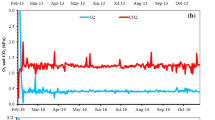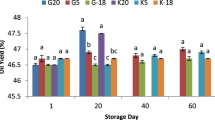Abstract
Mill olives (Olea europaea L. cv. ‘Lechín’), harvested at the green mature stage of ripening, were stored for 72 h under six different storage conditions: in air, in a closed container, and in a closed container with 30 ppm ethylene either at 20 or at 40 °C. The use of 40 °C as the fruit storage temperature reduced oil bitterness, regardless of the atmosphere applied; however, it also induced a significant reduction in stability and pigment content of the oil extracted. At 20 °C, mill olives stored under air supplemented with 30 ppm ethylene engendered oils with middle bitterness intensity, whereas the oils obtained from fruit stored similarly, but without ethylene, or in an open container exhibited a strong intensity of this sensory attribute. Fruit respiration in the closed containers caused a CO2 accumulation and an O2 decrease in the storage atmosphere. This CO2 concentration was increased by the previous ethylene addition, but O2 presence did not suffer an additional reduction. The use of modified atmospheres in fruit storage induced off-flavor development in the oils extracted, producing a significant reduction in the overall grading of their sensory quality.
Similar content being viewed by others
References
Garcia JM, Yousfi K (2006) The postharvest of mill olives. Grasas y Aceites 57:16–24
Wodner M, Lavee S, Epstein E (1988) Identification and seasonal changes of glucose, fructose and mannitol in relation to oil accumulation during fruit development in Olea europaea L. Sci Hortic 36:47–54
García JM, Mancha M (1992) Evolución de la biosíntesis de lípidos durante la maduración de las variedades de aceituna Picual y Gordal. Grasas y Aceites 43:277–280
Luaces P, Gutiérrez F, Romero C, Sanz C, Pérez AG (2007) Contribution of olive seed to the phenolic profile and related quality parameters of virgin olive oil. J Sci Food Agric 87:2721–2727
García JM, Seller S, Perez-Camino MC (1996) Influence of fruit ripening on olive oil quality. J Agric Food Chem 44:3516–3520
Yousfi K, Cert RM, García JM (2006) Changes in quality and phenolic compounds of virgin olive oils during objectively described fruit maturation. Eur Food Res Technol 223:117–124
García JM, Yousfi K, Mateos R, Olmo M, Cert A (2001) Reduction of oil bitterness by heating of olive (Olea europaea) fruits. J Agric Food Chem 49:4231–4235
García JM, Yousfi K, Oliva J, García-Diaz MT, Perez-Camino MC (2005) Hot water dipping of olives (Olea europaea) for virgin oil debittering. J Agric Food Chem 53:8248–8252
Maxie EC, Catlin PB, Hartmann HT (1960) Respiration and ripening of olive fruits. Proc J Am Soc Am Hortic Sci 75:275–291
Rugini E, Bongi G, Fontanazza G (1982) Effects of Ethephon on olive ripening. J Am Soc Hortic Sci 107:835–838
Tsantili E, Pontikis C (2004) Response to ethylene and its interactive effects with N6-benzyladenine (BA) in harvested green olives during ripening. Postharvest Biol Technol 33:153–162
Artajo LS, Romero MP, Suarez M, Motilva MJ (2007) Partition of phenolic compounds during the virgin olive oil industrial extraction process. Eur Food Res Technol 225:617–625
Castellano JM, García JM, Morilla A, Perdiguero S, Gutierrez F (1993) Quality of ‘Picual’ olive fruits stored under controlled atmospheres. J Agric Food Chem 41:537–539
García JM, Gutiérrez F, Castellano JM, Perdiguero S, Morilla A, Albi MA (1996) Influence of storage temperature on fruit ripening and olive oil quality. J Agric Food Chem 44:264–267
Pérez AG, Sanz C, Olías R, Olías JM (1997) Effect of methyl jasmonate on in vitro strawberry ripening. J Agric Food Chem 45:3733–3737
Martínez JM, Muñoz E, Alba J, Lanzón A (1975) Informe sobre la utilización del analizador de rendimientos “Abencor”. Grasas y Aceites 26:379–385
Gutiérrez F (1989) Determination of the oxidative stability of virgin olive oils: Comparison of the active oxygen and the Rancimat methods. Grasas y Aceites 40:1–5
Mínguez-Mosquera MI, Rejano-Navarro L, Gándul-Rojas B, Sánchez-Gómez AH, Garrido-Fernández J (1991) Color pigment correlation in virgin olive oils. J Am Oil Chem Soc 68:332–336
Mateos R, Espartero JL, Trujillo M, Ríos JJ, León-Camacho M, Alcudia F, Cert A (2001) Determination of phenols, flavones and lignans in virgin olive oil by solid-phase extraction and high-performance liquid chromatography with diode-array ultraviolet detection. J Agric Food Chem 49:2185–2192
Mateos R, Cert A, Pérez-Camino MC, García JM (2004) Evaluation of virgin olive oil bitterness by quantification of secoiridoid derivatives. J Am Oil Chem Soc 81:71–75
Ponce-Valadez M, Watkins CB (2008) Fermentation and malate metabolism in response to elevated CO2 concentrations in two strawberry cultivars. Physiol Plant 134:121–133
Gutiérrez F, Perdiguero S, García JM, Castellano JM (1992) Quality of oils from olives stored under controlled atmosphere. J Am Oil Chem Soc 69:1215–1218
Tian MS, Sheng CC, Li Y (1987) Relationship between ethylene release, membrane permeability and activity of polyphenoloxidase in duck pears (Pyrus bretschneideri Rehder) during low temperature storage. Acta Bot Sin 29:614–619
Knowles L, Trimble MR, Knowles NR (2001) Phosphorus status affects postharvest respiration, membrane permeability and lipid chemistry of European seedless cucumber fruit (Cucumis sativus L.). Postharvest Biol Technol 21:179–188
Candan AP, Graell J, Larrigaudiere C (2008) Roles of climacteric ethylene in the development of chilling injury in plums. Postharvest Biol Technol 47:107–112
Caponio F, Gomes T, Pasqualone A (2001) Phenolic compounds in virgin olive oils. Influence of the degree of olive ripeness on organoleptic characteristics and shelf-life. Eur Food Res Technol 212:329–333
Acknowledgments
The authors are grateful to the Project Citrisaude SP5.P120/03 of the Program Interreg IIIA of the European Community for their financial support. The authors also gratefully acknowledge M.C. Martínez for technical assistance and Sociedad Agraria de Transformacion N-1941 Santa Teresa de Osuna for supplying the olive fruit.
Author information
Authors and Affiliations
Corresponding author
About this article
Cite this article
Yousfi, K., Cayuela, J.A. & García, J.M. Effect of Temperature, Modified Atmosphere and Ethylene During Olive Storage on Quality and Bitterness Level of the Oil. J Am Oil Chem Soc 86, 291–296 (2009). https://doi.org/10.1007/s11746-009-1348-9
Received:
Revised:
Accepted:
Published:
Issue Date:
DOI: https://doi.org/10.1007/s11746-009-1348-9




